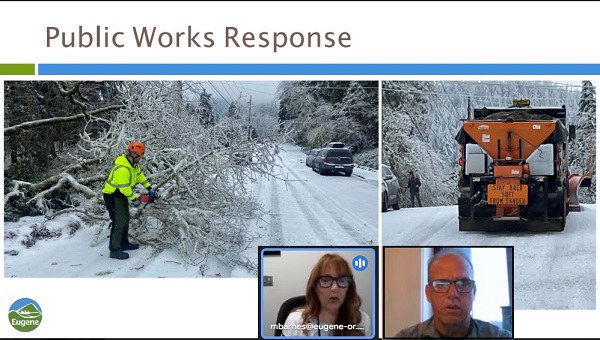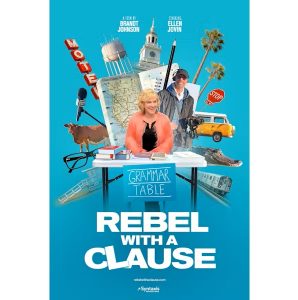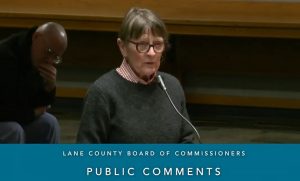Public Works, CERTs share successes from ice storm response
14 min read
Neighbors and CERT teams can best help the city during a disaster by using their networks to share emergency information. The Neighborhood Leaders Council’s preparedness committee invited Public Works to discuss the ice storm. On April 18:
Marion Suitor Barnes (Eugene Public Works): I’m Marion Suitor Barnes, I’m the Public Affairs Manager specifically for City of Eugene Public Works, but in this last storm event, I somehow ended up as the only public information representative with the city who had power and internet the entire time. And a result, I ended up sort of picking up the slack as the public information person for the entire city during the event. So I got a little bit more of a global view than I was anticipating, but here we are. It helps me learn a lot very quickly.
[00:00:45] So the first thing I just want to share is that watching weather ahead of time is very important to us. So this last storm specifically, but just in general, we are always watching weather, multiple days out. We are tied in with the Northwest Weather Service that gives us multiple daily updates on what the weather’s looking like.
[00:01:06] And so we knew that this one was coming. Of course, as we’ve all learned from living in Eugene, you never actually know what the storm’s going to look like. I think we all might have been taken a little bit by surprise by this last one. We knew that there could be a little bit of snow and maybe some ice, and that is what we prepared for, for the most part. We always have the capability to pivot, as we did this time, to different tactics. But what we knew from the outset was that we were going to need our de-icer, we had our snowplows loaded up, you know, we were ready to go.
[00:01:36] You may have seen coverage of our preparation starting early—as early as Wednesday—when the storm was expected Saturday. So we knew it was coming and then on that Saturday it did. There was a little bit of rain, there was some ice. We had to put de-icer down, but it had been raining for several days and the de-icing fluid just does not work well. It tends to wash off, you know, if it’s raining in advance. We’re often stymied here in Oregon because the weather in the wintertime often is rainy, and that makes the anti-icing, that’s magnesium chloride, makes that a little less effective.
[00:02:11] So we were ready to go and on Saturday morning, very, very early in the morning, we went ahead and activated what we call in Public Works, we call it the RIC. It’s Roosevelt Incident Command, which just means the maintenance yard that’s out on Roosevelt Street. That is when, again, Public Works Maintenance and Parks And Open Space, to some degree, sort of jump into action.
[00:02:34] And we started getting crews out there, clearing roads, doing all of those things. I was in a couple of these meetings and there were easily 40 to 50 people from all walks of Maintenance and the Parks and Open Space and even other areas of department, planning for what we were going to do.
[00:02:54] Once we activated the incident response, we had some smaller crews actually working around the clock. So we were on 12-hour crews around the clock. People were sleeping overnight at the yard. It was pretty awesome, the dedication that people showed, and I would like to just offer kudos to the Maintenance crews who view this service to the community as, like, the thing that they are most proud of. It’s them wanting to give back to their community, and so it’s really inspiring how hard they work through all of this.
[00:03:28] That’s where we really love to hear from the public, some of the social media comments and positivity that we were getting from the community, thanking the crews for their work. That really helped keep them going. Thank you for that, ’cause it really was a morale booster after, you know, some of the shifts got up to like 36 hours. So it was pretty brutal. There were running power outages. They worked Saturday and Sunday and even Monday, which was a holiday, if you’ll recall, keeping roads clear, dealing with tree hazards but it was that second round of ice that came around Tuesday that really was the doozy, particularly for trees for us.
[00:04:04] When the ice after that Tuesday event got so thick—it was up to like three inches on the roadways in some places—obviously, that’s much too thick for the de-icer to make much of a dent. And so at that point, we were really focusing on the sanding, particularly around intersections.
[00:04:20] The first thing that we are responsible for, whether it’s ice or snow, is really: it’s priority roads. So if everyone’s looked at our map online, there’s priority one, two, and three roads. What we’re trying to do is keep those priority routes clear for emergency responders, for LTD, for school buses if school is in session, that wasn’t the case here. But all of those other services that we partner with to respond to a storm, it is our job to make sure they can get where they need to go. And this will be the case in any emergency.
[00:04:54] We were doing shifts of 12 (hours) all the way through Wednesday, trying to get the ice, trying to get the trees clear. There’s a whole hierarchy of which things we’re going to try to address first: Any tree that is actually in the roadway or any hazard of any kind that is in the roadway. For example, one of the earliest things that happened was a massive tree fell across Cal Young. And so we had to get out there and get that clear. If I recall correctly, they were doing it like four o’clock in the morning, very, very early. They were out there trying to get that clear for the morning commute. We wanted people to stay home, we knew not everybody could, so they were out there.
[00:05:33] Our urban forestry team takes care of city trees, but we train people who are not even with the urban forestry team on how to use chainsaws and how to do these things safely, so that in these circumstances, we can expand our crews. We pull from other crews that normally do other things and they are out there doing urban forestry-type work in order to get those hazards cleared more quickly.
[00:06:00] We are fortunate to have some some fantastic software that really allows us to keep track of our work, not just work orders in general, but again, specifically trees. We have a platform that literally is a ‘location, condition, photo, species’ of every single tree the city owns, thousands of trees are all in this database, and that is how we were tracking, how we were getting those trees out.
[00:06:27] And, in a lot of cases, how we were partnering with EWEB and other utility providers in order to make sure that we were able to get the tree hazards mitigated at the same time that they were dealing with power outages and power lines.
[00:06:40] At some point we were over 2,000 requests for service, all 5,200 gallons of de-icer, 800 lane miles, all those cubic yards of sand (which then we have to go back and pick up afterwards, lest they pollute the environment), all of the miles plowed. It was just a Herculean effort, and all of the efforts and the coordination and planning that goes on because these Maintenance crews and Parks and Open Space crews have done this so many times, they’re pretty well versed in how to make it happen.
[00:07:16] Public Works is considered a first responder in the same way that police and fire are, again, because police and fire can’t get places unless we’re clearing the roads for them. And so if you go out to our yard, we proudly display a first responder flag. That lets people know that we do play an integral role in that as well.
[00:07:36] Some other things that we just like to share with people that are kind of common misconceptions that we heard from people during the storm are things around snowplows and kind of how they work. I think a lot of people expect that after a plow goes by, it’s going to be bare pavement and that’s not the case. We don’t plow to bare pavement for a variety of reasons, mostly revolving around the fact that it will severely damage the roads and we don’t want to make taxpayers pay for more repairs.
[00:08:04] But we also have crosswalk signs and things like that are actually elevated on the road surface because they’re applied on top and so we wouldn’t want to be damaging those either as we were plowing. So there will always be a little bit of snow left on the ground after plows come by and again, those are just all things that I think a lot of people don’t know about.
[00:08:24] And I also brought with me today Eric Johnson, who has been with Public Works Maintenance, which is the division of Public Works that does most of this work, for many, many, many, many, many years, and we were talking about what we would do in the future if we had a large-scale event and I just wanted to share with the group that we do have contracts with nationwide companies that specialize in mitigating large-scale events.
[00:08:55] Eric Johnson (Public Works Maintenance): We’ve learned over, I think, going back to like 2002, the windstorm we had in, I think it was February, and we really learned a lot about our capacity to deal with such a large area when it comes to downed trees or ice storms or snowstorms.
And since then we’ve been building different tools and forming different contracts to be able to handle larger events, because our capacity at Eugene is, you know, we do really well on a day-to-day basis, but when we have big events, it takes more than we have the capacity to deal with. So we reach out, we have intergovernmental agreements with Lane County, ODOT, Springfield, other areas that we try to partner with during these events.
[00:09:50] We recently went into contract with some outside sources that if we had, say, a large weather event or a Cascadia (Subduction Zone earthquake) event, that we can bring in resources from all over the country, actually, to help us manage that. In fact, to the point where they almost take over the management, and they’re working with federal governments and state governments, because, really, it’ll take more than the staff that we have.
[00:10:20] And a lot of our staff are impacted by the events that we have. We had a lot of people working in this event that had no power for up to, I know some people, up to 12 days with no power, yet they were showing up to work every day. And others that couldn’t leave their homes because the roads were closed and they were having problems.
[00:10:40] So we really need to rely on others to help us out. So we’ve got big contracts out there where we can bring in a lot of resources to help us with debris removal, processing debris, and that’s a big relief off of our shoulders right now. We haven’t had to activate that yet, but we are in communication with those contractors and feel comfortable that we’re set up to support the residents of Eugene if we do get into a big event.
[00:11:14] One of the counties up in the Portland area developed this and we piggybacked off it and it took us a couple years to develop it, but yeah, we are, I think we are the only city right now in Oregon that has a contract like this, and I’m sure others will start looking at that too.
[00:11:36] Heather Sielicki (Chair, Southeast Neighbors Preparedness Committee): I wondered what can neighborhood associations and community-based organizations do to best support Public Works activations or help ensure safety and messaging?
[00:11:51] Marion Suitor Barnes: Thank you, Heather. The thing that’s always a challenge is getting information out. So we always are looking for people to carry our message. And all of the communication that the city of Eugene did about this, the ground zero for that was all on our website. So we had daily press releases posted on the city of Eugene website, just right there on the home page, top of that. So if neighborhood associations or CERT groups were watching those and just being up to where we were, where we stood, they would know what the city was going for, what help might be needed, and particularly in this last case—you know, full disclosure—where we were not being helpful and maybe where there are gaps that you can fill in.
[00:12:37] As we all know mobility was such an issue in this particular storm, that it really limited I think a lot of people’s ability to jump in and help as they wanted to. So, yeah, just being an advocate for what we are trying to get done and a partner with the city, we’ll be, in the next event, thrilled to talk to any groups about what could be done or how they might be able to help.
[00:13:06] Andy Davis (Eugene Springfield Community Emergency Response Teams): I just wanted to let folks know, during the ice storm, the Eugene Emergency Communication System, or EmComm Net, we activated on the Saturday morning, at 10 a.m. And we were on the air around the clock until Wednesday, that following Wednesday, at 8 p.m.
The Eugene Emergency Communication System is sponsored by the Eugene Springfield CERT program, made up of ham radio operator volunteers of the city and also CERT members. And so we provided communication assistance from all over the county.
[00:13:49] We were talking to Cottage Grove, Creswell, Veneta, Junction City, Springfield; we got requests to notify family members to let them know that they were well and fine just out of power but they were okay so we did that. When we could not make the phone call, we sent a text through the phone and that went through well, so we were able to do that.
[00:14:13] We assisted visitors that were stuck in Eugene on I-5. They were at the Coburg RV park and the park power went out and so they needed to find some propane for their RV because it was cold. So we looked around, and through many linking with other people online, we were able to tell them who had propane and so they were able to secure that for their RV to stay warm. So we were busy and so we were just trying to help out as much as we could. We got road conditions—what roads were blocked and things like that—we passed, anything that we came along we passed it along. So we were busy.
[00:15:00] Chris Jockheck (Chair, Southwest Hills Neighborhood Association): Is there a particular radio station that is designated sort of as a go-to radio station for public information that you use?
[00:15:15] Marion Suitor Barnes (Eugene Public Works): That’s a great question. KLCC is the one that I routinely talk to the most and they’re the easiest to get ahold of. And they were willing to come in and record at times that they normally wouldn’t.
[00:15:27] As far as the TV goes, they were all pretty on the spot as far as coverage. Anytime we had something new to share or an update, very willing to share that, including one night, like before the 11 p.m. news. It was 10:45, and I was texting them something new, and they still managed to get it on that late-night broadcast. So they also showed a great effort in making sure that they were getting information out.
[00:15:54] As far as alerts and information, I know that you all are probably pushing your groups toward Lane Alerts already. But we don’t have, with Public Works, a fantastic way to get to just huge swaths of people. Even if you count our social media, all the TV coverage, all the radio coverage, we’re still getting maybe a quarter of the population, if we’re lucky. It’s probably more like 10%.
[00:16:20] And getting back to what Heather was asking about, how you could help: That sharing of correct information based on what’s on our website would be fantastic, just to have all y’all, like, amplifying our voice in all of the platforms that you have and the ability to share information out to help amplify the city’s voice. That’s wonderful.
[00:16:45] Eric Johnson (Public Works Maintenance): The good thing is, though, and I’ve got to mention this, it was successful from an operations standpoint because we had no injuries for our 200-300 staff that were responding to this and no equipment accidents. You know, we had our normal breakdowns but not what I would consider an accident. So that’s a success for us.
[00:17:10] And then the last thing is this event was large enough when you combine Lane County and all the damage that was done in Lane County, it became a FEMA-qualified event. And so we’ve learned over the years to be able to track and document and do all the things that FEMA requires so we can get money back for all the work, you know, that because it’s an expensive event, especially this one. And so we do a really good job of tracking all that, doing everything we need to do to be able to get funding back from FEMA to replenish our operation budget that we have to deplete to be able to do this.
[00:17:59] Marion Suitor Barnes (Eugene Public Works): Two of the things that we hear a ton when people are calling is that medication piece, making sure that people are stocked up on their medication. We, because city of Eugene Public Works is reliably going to answer the phone out at the Roosevelt yard, we end up getting a lot of these questions, a lot of these life sort of support, health support-type questions, even though they’re not really our bailiwick and we do, again, back to 211, try to send people that way. But making sure that people are prepared, if they’re elderly or if they are, they really need that support as far as medication is concerned or other life services go, that’s a big one.
[00:18:41] And then the other one is if we know that snow is coming, we like people to move if they live on those priority routes, move their cars before the storm comes because what happens is they get iced into place. And then you have an emergency and you have to go to the hospital or you have to get medicine and whatever, and you can’t move because your car is iced into place. And we also can’t plow in that area if that car is stuck there. So we really would love support in helping your neighbors move their cars into a safer space if you are on a priority route.
[00:19:14] John Q: The CERTs and Public Works share successes during the ice storm, and discuss ways to improve our community response in the next disaster.




